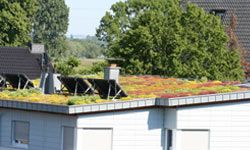Did you know that the Obama Administration's American Recovery and Reinvestment Act has allocated more than $80 billion to clean energy technology [source: White House]? As industry continues to expand and the world's supply of non-renewable resources slowly grows rarer and more expensive, green construction becomes more than an environmentally friendly option: It becomes a necessary step in how we live our lives. Thankfully, clean energy technology is more advanced than ever before, and can be as beneficial for your wallet as it is for the Earth. Green technology, like solar power, may look pricey up front compared to traditional resources, but over a lifetime of use, you'll end up saving on energy costs.
But what exactly is green construction technology? It's a wide category, covering everything from energy-efficient appliances to geothermal heating. The 10 on this list strike a balance between eco-friendly building materials everyone can use when building a new home and more advanced green technologies that bring cool advancements in science to the construction industry -- think bio-degradable paint (did you know it's made using milk?) and glass that tints on command. These may be the materials and technologies everyone uses in the future, but why wait? They're available right now.
Advertisement




